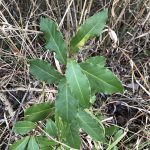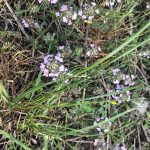Some Healing and Magical Trees and Herbs on the Coasts of the Mediterranean
Hi everyone, this is Alex, a Priestess of Cerridwen from Italy!
I would like to share with you some of my favourite herbs and plants, among those that grow on the beautiful shores of the Mediterranean Sea here in Italy.
Sea view at the Aeolian Islands, Sicily (Photo by Alex La Malfa)

Why choose the plants of these coasts, among the many Italy offers?
Well, because they are part of the complex biome usually defined as Mediterranean scrub/forest, which is present in very few places around the world, and has unique characteristics and peculiar plants…
Despite being from a land very far from Cerridwen’s native Wales, I never encountered difficulties in working with the plant spirits of our coasts under Her guide: Cerridwen’s ways are wonderfully and magically capable of adapting to the most different environments, and the Swynwraig’s domain has no limits or bonds… because She understands the hidden language of every Nature spirit; She is the loom where the tapestry of their songs, and energies, can be woven.
She has always helped me to tune with the plants’ spirit, leading me to the ones I needed right at that moment.

Saying “Mediterranean scrub”, I’m sure that most will picture in their minds sunny landscapes like the one above, where the dry soil and the wild vegetation frame views of equally wild scenery… and it’s pretty much so!
From a scientific perspective, the Italian coasts present a variety of ecosystems that include the Mediterranean scrub, the Mediterranean forest, the “gariga” (a type of low scrubland that can be a way of the landscape to adapt to difficult conditions such as aridity, erosion, wildfires), and others.
The areas that overlook the Mediterranean Sea usually have, to oversimplify, warm and dry summers, and mild winters (there are many variations on this, though).
These landscapes are full of energy and untamed strength… They are wild and harsh… intense.
The shore is, as we know from every folklore around the world, a liminal place where land and sea meet, and both somehow mingle, becoming something “in-between”, something different… and this characteristic is obviously reflected in the flora that grows here.
The plants adapted to survive the long and very hot summer months in which rain never falls, and wildfires happen: they are often evergreens, with thick wood or thick leaves and thorny branches, and resist tenaciously the harsh conditions growing at a very slow rate. They may be herbaceous and survive the summer as seed.
They may be plants adapted to grow on sand, or in crevices and crannies between cliff rocks, in the briny air of the beach.
Today I would like to talk to you about four of them with which I work a lot.
BAY LAUREL (Laurus nobilis)
This powerful plant is integral part of the Mediterranean scrub, along with Holm oak, Cork oak, Olive, Stone pine, Maritime pine, Cypress, Juniper, Oleander, Palm trees (in the warmer zones), and also Walnut, Ash, Elm, Willow, Hornbeam, Maple (in colder zones), to mention some.
Baby Bay Laurel growing, Adriatic coast, Italy (photo by Alex La Malfa)

Bay laurel has anti-inflammatory activity, as well as antibacterial, antiviral, antioxidant activity; it acts as a mucolytic, analgesic and immuno stimulant; just to mention some of its many properties. It is a beloved herb in Mediterranean cooking, and it’s always present in Italian kitchens.
In ancient Greece, its leaves were used by Pythia, the famous Delphi’s Oracle, chewed and/or burned as incense, to facilitate altered states of consciousness and enable the priestess to enter in contact with the god Apollo, and channel prophecies from him (there is evidence that in ancient times it was an oracle dedicated to Gaea, Mother Goddess and personification of Earth).
Bay Laurel was sacred to Apollo, the Sun god, and was used, both in Greece and Rome, as symbol and acknowledgement of excellence in art, wisdom, prowess in battle: poets kept laurel twigs while declaiming their verses, and military leaders carried laurel wreaths to celebrate their victories.
Theocritus mentioned in his Idylls a recipe for an incense dedicated to Hecate which featured Laurel as one of its ingredients.
Laurel was grown everywhere, from poor houses to rich ones, to ensure luck, protection and good health.
Laurel’s qualities are hot and pungent; it lends energy and strength to every preparation to which it’s added. These qualities, united to its slightly narcotic and sedative effects, help us to remain steady and strong, to increase our self confidence and our ability to challenge ourselves in life, finding and using our inner resources. It helps us to lead the way with wisdom.
This regards also the ability to cross the veil between the worlds, as the ancient Phytia knew… this is surely an experience that challenges our conscious mind, and through which we can pass unharmed only with the necessary confidence and trust, in ourselves and in the Goddess.
I like to use Laurel leaves in incense, mixtures or oils to ignite them with the energy of the intent, and I find them a perfect addition to an incense meant to support all the practices of a Seer, from meditations and ritual journeys to Oracling and Embodiment.
Be careful not to confuse Bay Laurel with Cherry Laurel (Prunus laurocerasus), a widely cultivated shrub whose leaves resemble Bay Laurel ones, but that is toxic!
OLIVE TREE (Olea europaea/Olea europaea var.sylvestris)
Everyone knows this incredible plant, which is a familiar sight for all who travel these shores, and whose fruits produce the precious oil that is so beneficial for our health.
Needless to say, olive oil is a staple of Italian and Mediterranean cooking, and has been also used as a medicine, a cosmetic, and a base for infusing herbs and plants for all kinds of ritual and healing purposes throughout the centuries.

Olive tree in the background with Bougainvillea, Aeolian Islands, Sicily (photo by Alex La Malfa)
The Olive is a small tree native to Asia minor and Syria, that is thought to have been first cultivated around 6,000 years ago. From those regions, it has gradually spread into the whole Mediterranean through Egypt and Greece.
Along with grapes and wheat, olive is considered to be one of the plants whose cultivation gave a major impulse to the development of complex societies.
Olive oil is renowned since antiquity for its excellent properties and high nutritional value: it has strong antiinflammatory and antioxidant activity, which, together with the high content in monounsaturated fats and vitamins A, D, E and K, makes it a great ally for the prevention of cardiovascular diseases and maintaining a good health in general.
Olive oil’s soothing and nurturing effects on the skin were well known to the Egyptians and the Greeks, for whom the tree was sacred to the Goddess Athena.
In Greece the tree was so venerated that cutting it was a crime punishable with exile or even death.
Olive oil has always been used in ritual context in all cultures and religions of the Mediterranean basin, from Egypt’s mummification process to the use of anointing oils in Judaism and Christianity.
For its innumerable gifts, the olive tree symbolises abundance, wealth and well-being.
The strong smell and greasy texture of its fruits and oil are protective and nourishing not only on a physical level, but also on a spiritual one: that’s why olive oil has been used since the distant past to anoint people joining a ceremony, or to make someone king or queen.
The protective action of the olive tree is reflected in the old practice, in the Italian countryside (especially in the regions of the centre and south), to use oil to discover if “malocchio” (evil eye) had been cast upon a person, and to remove it: some drops of oil were poured into a bowl of water, and the result was interpreted, while reciting some prayers, based on the behaviour of the oil drops. If they stayed together and compact, there was nothing, but if the drops coalesced and stayed on the bottom of the bowl, it was a sign of a strong curse that would require many spells and oil readings to be eliminated.
Olive trees have been attributed also the symbolism of peace, being associated in the Greco-Roman world to Athena, goddess of wisdom and war (she gifted the olive tree to the people of Athens, who then chose her as tutelary deity, and used olive branches and wreaths as a symbol of celebration and fruitfulness) and to Roman peace deities like Eirene or Mars Pacifer (bringer of peace, another aspect of Mars).
In Christianity, again the olive tree came to symbolise peace and rebirth (see the dove with the olive branch in the beak that announces the end of God’s wrath in the Universal flood). The association is very much alive today, not only in mass culture: for example, on the occasion of the festivities of Easter, here in Italy, it is custom to give it in the form of blessed olive branches, that are distributed at the church to everyone.
To me, olive oil is the first choice for my oil infusions: I know some aren’t so happy about its strong scent, which could indeed partly “cover” the fragrance of essential oils or herbs added to it… but personally I love its smell, and I find it combines well with other scents, giving a more “natural” effect to the final product…
Cerridwen has given me various recipes for anointing oils, both for magical tools and for the body: I love to add some locally harvested Mediterranean herbs that grow in my surroundings, like Helychrisum, Calendula, Rosemary, Wild thyme, Juniper, Lavender…olive oil, with its richness, is wonderful for abundance spells, and it also makes a lovely offering for the Spirits of the land!
ROSEMARY (Rosmarinus officinalis)
This beautiful native Mediterranean herb’s name probably derives from the Latin “Ros Marinus”, which means “sea dew”, to highlight its natural environment near the coasts.

Rosemary in bloom by the sea, Adriatic coast, Italy (photo by Alex La Malfa)
Rosemary’s properties make it a great aid for improving concentration and memory, for helping the digestion, protecting the liver, for treating inflammatory diseases like arthritis, and for the problems of cardio-vascolar system, as a circulatory stimulant. It’s also a tonic for the whole body in case of stress; its hot nature brings with it the warmth of the sunny coasts in which it grows.
Full of light and life, Rosemary was used both for sacred purposes and in the mundane life since Egypt: it was present at weddings, funerals, celebrations; it was used as wreaths by greek and roman students to aid memory and mental energy, but it was considered to have ties to memory in general, including keeping the beloved one in one’s thoughts when not together, and remembrance for those who passed away.
Rosemary was thus associated also to love: it was included in love potions and filters, and used as male aphrodisiac.
It was used as a disinfectant in the houses and rooms of the sick, as preservative for food and as aid for digestion; also in the Arab world Rosemary was regarded as a “cure-all”.
Its fame continued in the Middle Ages so much that Charlemagne, during his reign, included it in a series of rules on land management as a plant to absolutely grow.
Through the centuries, Rosemary’s reputation remained intact, as demonstrated by the popularity of many beauty and medicinal recipes which featured its presence, such as The Queen of Hungary’s water, the Four Thieves Vinegar, and many others.
Rosemary brings clarity and purification, like the pure air or the sea climate in which it grows, but also warmth and brightness, like the fiery sun energy of the Mediterranean summers.
It chases away exhaustion, sadness and discouragement; it opens to self awareness and gives vitality.
In my experience and in the work with Cerridwen, I found that Rosemary brings with it the energy of the Fire and the steadiness of Earth: it helps in bringing clarity to memories of the past in order to keep what has to be kept, let go what we no longer need, and open to a clean vision of what is next.
For working with this beautiful herb, I find it particularly useful to burn Rosemary as incense, to wear it in a little sachet, and to use the oil infusion: just a few rubs with the hands release its wonderful warmth and fragrance! It has helped me tremendously with shadow work, especially at Samhain time, bringing a steady light in the dark of the moment.
THYME (Thymus vulgaris)
The last Mediterranean herb I would like to talk to you about is the wonderful and aromatic Thyme.

Thyme in bloom, Adriatic coast, Italy (photo by Alex La Malfa)
Thyme is a powerful disinfectant, and is very effective in aiding the treatment of colds, coughs, sore throat and all the typical winter problems. It’s a tonic, supporting the body’s functions, and works well as a stimulant for the thymus gland.
In the Greek world it was saluted as “Zeus’ breath”, being associated with courage, and was used in all ancient world for its antiseptic, expectorant and digestive properties.
It was also called “Mother Thyme”, for its ability to aid with menstruation problems and birth, so much that Culpeper assigned Thymus under the influence of Venus.
Its fame continued in mediaeval times, like for Rosemary; the dames used to gift their knights some Thymus twigs for protection and strength in battle.
Thymus quickly became an emblem of health, courage, and also a helper in the search for love.
In Sardinia, Thymus was used in amulets to protect from nightmares, and, in all Italy, it has been part of herbs used for the “water of Saint John”: a simple water infusion made with fresh flowers gathered on Saint John’s day’s eve (the night before the24th on June, obviously echo of Midsummer celebrations). This water, the morning after, was used to wash the face for special protection from every evil, malice, curse.
The protection properties of Thyme are revealed also in a germanic saga, which explains that a mother sewed some Thymus and fern into her daughter’s dress, because she wanted to leave with a suspicious stranger, declaring herself in love, all of a sudden. When the stranger came to bring with him the girl, just coming in contact with the dress caused him to dissolve, revealing his diabolical nature.
In my practice, I love to use Thyme as an “eye opener” when I’m in doubt: in our Cerridwen Wheel, Thyme is one of the herbs of the West and the Earth season, and it has indeed helped me a lot to stay grounded and vigilant, with full awareness of what I had around, when I was in an unclear situation, and giving me the courage to overcome the difficulties on the path.
I love its aromatic scent, and I use it in “kitchen magic” as often as possible: a good bread with Thymus and other aromatic herbs, made with intention and love, truly brings harmony and protection to the whole family that eats it!
Thank you so much for staying with me in this brief walk into the world of Mediterranean plants and herbs… I would love to hear your experiences and comments!
Blessed be, Alex

Alex La Malfa
Emilia Romagna, Italy
Instagram: @song_of_the_waves @songs_from_the_cauldron
Alex is a Priestess of Cerridwen from Italy. She has been on the path of paganism and Goddess spirituality for 20 years, and has a huge passion for herbs, crystals, painting, folk traditions and all works of reconnection with the land.